
Related
The White House is dismissing the findings of a medical study that says 650,000 people have died in Iraq since the U.S.-led invasion. The study was conducted by American and Iraqi researchers and published in the prestigious British medical journal, The Lancet. We’re joined by the report’s co-author, epidemiologist Les Roberts. [includes rush transcript]
More than 650,000 people have died in Iraq since the U.S. led invasion of the country began in March of 2003. This is according to a new study published in the scientific journal, The Lancet. The study was conducted by researchers at the Johns Hopkins Bloomberg School of Public Health and Al Mustansiriya University in Baghdad. Researchers based their findings on interviews with a random sampling of households taken in clusters across Iraq. The study is an update to a prior one compiled by many of the same researchers. That study estimated that around 100,000 Iraqis died in the first 18 months after the invasion.
Les Roberts joins us now from Syracuse, New York — He is one of the main researchers of the study. He was with Johns Hopkins when he co-authored the study but has just taken a post at Columbia University.
- Les Roberts. Co-author of the study on civilian mortality in Iraq since the invasion. He was with Johns Hopkins when he co-authored the study but has just taken a post at Columbia University.
Transcript
AMY GOODMAN: Les Roberts joins us now from Syracuse, New York. He’s one of the main researchers of the study. He was with Johns Hopkins when he co-authored the study but has just taken a post at Columbia University. Les Roberts, welcome to Democracy Now!
LES ROBERTS: Hi, Amy. It’s nice to be with you again.
AMY GOODMAN: It’s good to have you with us. Why don’t you lay out exactly what you found?
LES ROBERTS: Sure, we, as you said, went to about 50 neighborhoods spread around Iraq that were picked at random, and each time we went, we knocked on 40 doors and asked people, “Who lived here on the first of January, 2002?” and “Who lived here today?” And we asked, “Had anyone been born or died in between?” And on those occasions, when people said someone die, we said, “Well, how did they die?” And we sort of wrote down the details: when, how old they were, what was the cause of death. And when it was violence, we asked, “Well, who did the killing? How exactly did it happen? What kind of weapon was used?” And at the end of the interview, when no one knew this was coming, we asked most of the time for a death certificate. And 92% of the time, people walked back into their houses and could produce a death certificate. So we are quite sure people didn’t make this up.
And our conclusion was comparing the death rate for that 14 months before the invasion, with the 40 months after, that the death rate is now about four times higher. And, in fact, it’s twice as high as when we last spoke two years ago and when we did our first study. So, things have gotten bad, as you stated. We think about 650,000 extra people have died because of this invasion, and about 600,000, some 90%, are from violence.
JUAN GONZALEZ: Well, I’m sure you have heard by now the responses of President Bush and military leaders about this. What is your response to their saying that this is not credible?
LES ROBERTS: You know, I don’t want to sort of stoop to that level and start saying general slurs, but I just want to say that what we did, this cluster survey approach, is the standard way of measuring mortality in very poor countries where the government isn’t very functional or in times of war. And when UNICEF goes out and measures mortality in any developing country, this is what they do. When the U.S. government went at the end of the war in Kosovo or went at the end of the war in Afghanistan and the U.S. government measured the death rate, this is how they did it. And most ironically, the U.S. government has been spending millions of dollars per year, through something called the Smart Initiative, to train NGOs and UN workers to do cluster surveys to measure mortality in times of wars and disasters.
So, I think we used a very standard method. I think our results are couched appropriately in the relative imprecision of [inaudible]. It could conceivably be as few as 400,000 deaths. So we’re upfront about that. We don’t know the exact number. We just know the range, and we’re very, very confident about both the method and the results.
AMY GOODMAN: Les Roberts, this was President Bush when he was asked about the study Tuesday, during his morning news conference. He dismissed the study, as you know, and said Iraqis are willing to tolerate the level of violence in Iraq. The question came from CNN’s Suzanne Malveaux.
SUZANNE MALVEAUX: A group of American and Iraqi health officials today released a report saying that 655,000 Iraqis have died since the Iraq war. That figure is 20 times the figure that you cited in December, at 30,000. Do you care to amend or update your figure, and do you consider this a credible report?
PRESIDENT GEORGE W. BUSH: No, I don’t consider it a credible report. Neither does General Casey, and neither do Iraqi officials. I do know that a lot of innocent people have died, and that troubles me and it grieves me. And I applaud the Iraqis for their courage in the face of violence. I am amazed that this is a society which so wants to be free that they’re willing to — you know, that there’s a level of violence that they tolerate. And it’s now time for the Iraqi government to work hard to bring security in neighborhoods, so people can feel, you know, at peace.
No question, it’s violent. But this report is one — they put it out before. It was pretty well — the methodology is pretty well discredited. But I — you know, I talk to people like General Casey and, of course, the Iraqi government put out a statement talking about the report.
SUZANNE MALVEAUX: The 30,000, Mr. President? Do you stand by your figure — 30,000?
PRESIDENT GEORGE W. BUSH: You know, I stand by the figure. A lot of innocent people have lost their life — 600,000, or whatever they guessed at, is just — it’s not credible. Thank you.
AMY GOODMAN: And again, this was General George Casey, the top U.S. military leader in Iraq, who was also asked about the Lancet study.
GEN. GEORGE CASEY: I have not seen the study. That 650,000 number seems way, way beyond any number that I have seen. I’ve not seen a number higher than 50,000. And so, I don’t give that much credibility at all.
REPORTER: What’s the 50,000 number? Where did you see that from?
GEN. GEORGE CASEY: I don’t remember, but I’ve seen it over time.
REPORTER: Is it a U.S. military estimate?
GEN. GEORGE CASEY: I don’t remember where I saw that. It’s either from the Iraqi government or from us, but I don’t remember precisely.
AMY GOODMAN: General George Casey and President Bush. Les Roberts, your response, and also to President Bush saying Iraqis tolerate this level of violence.
LES ROBERTS: Well, you know, we didn’t do a poll of Iraqis about their tolerance for the level of violence, but I think that Iraqis are pretty unhappy with the level of violence. And I think there are a couple of issues that arise, because of this. First of all, you know, I’m not so surprised that entities that monitor newspaper reports or groups that are looking at official government statistics think that it’s ten times lower than the real number.
We have gone and looked at every recent war we can find, and only in Bosnia did all governmental statistics add up to even one-fifth of the true death toll. And in Bosnia, the rate was 30 or 40 percent, with huge support for surveillance activities from the UN. So it’s normal in times of war that communications systems break down, systems for registering events break down.
And in Saddam’s last year of his reign, only about one-third of all deaths were captured at morgues and hospitals through the official government surveillance network. So, when things were good, if only a third of deaths were captured, what do you think it’s like now?
And another thought is that — quite unrelated — if someone said in the 9/11 attacks, “I think only 200 or 300 people really died,” we would be really, really upset. And I think in the long view, the danger of discarding this study, if it’s correct, is that, at a moment when we as a society should be showing contrition, our leaders have essentially expressed indifference to an extraordinary level of suffering. And that’s just the wrong message in terms of either our long-term security or peace in the Middle East.
JUAN GONZALEZ: Les Roberts, I would like to ask you something about the methodology of the study. Clearly in Iraq, as in most wars of this type, the level of violence is uneven across the country. It might not necessarily even correspond to the population densities of different areas. What was the methodology that you used to select the particular clusters that you chose?
LES ROBERTS: Sure. That’s a great question. And you’re right. In Iraq, there is a huge difference in death rates between, for example, the Kurdish north, which is relatively safe, and the Sunni Triangle, where the death rates are extremely high. And what we did was we got a population estimate of every government, from the Iraqi government, and we randomly allocated these 50 clusters that we were to go visit proportional to the population in each of those governments, so that, if in the Kurdish north there is only 20% of the population living in the couple safest provinces, we would naturally end up with a sample that’s 20% or so from that zone.
And then, once we had picked that we were going to visit two or three neighborhoods in a certain governance or province, we would then make a list of all the villages and towns and cities, and again randomly pick one of those to visit, so that big places had a larger chance of being visited than smaller places. And then, finally, when we got down to the village level or to the section of a city, we would pick a house at random, visit it and the other 39 houses closest to it to grab a cluster of 40 houses. And luckily, in the analysis, we can sort of look at how much variation there was between clusters.
And when we reported this, we didn’t say it was 655,000 deaths. We said it was 655,000 deaths, and we’re 95% sure it’s between about 400,000 and 950,000. And that range of imprecision is capturing that variance between neighborhoods that you described, some places having a lot of violence, and some not. So there is less than a 2 percent chance that the number is well below 400,000. So, you know, it’s not precise. It’s incredibly hard to do this kind of work in times of war, and I think that this is awfully good, given the conditions.
AMY GOODMAN: Les Roberts, there are some, like a very much quoted analyst, Anthony Cordesman, who are saying this is just a matter of politics. You released this study right before the election. This isn’t science. It’s politics.
LES ROBERTS: Well, if I’m not mistaken, Anthony Cordesman was formerly a Pentagon official, and, you know, I think he probably has a political lens in what he says. But this study has been underway for most of a year, in terms of organizing and getting it all together. It was done in June through July. It took some time to get the data out of Iraq, because of the logistical troubles of moving people in and out. We analyzed it carefully. We submitted it to The Lancet quite a while ago, and The Lancet had control over when this came out.
And I think this is just a lose-lose situation. You know, if this had come out two weeks ago, people would be saying the same thing. If this came out in the months after or the two months after the next election, people in Iraq would see this as very political in timing. So, you know, any time within a several month window here, we were going to get this accusation, and I just think it’s bunk.
And more importantly, is it true? It is easy — it’s going to be very easy for a couple of reporters to go out and verify our findings, because what we’ve said is the death rate is four times higher. And a reporter will only have to go to four or five different villages, go visit the person who takes care of the graveyard and say, “Back in 2002, before the war, how many bodies typically came in here per week? And now, how many bodies com in here?” And actually, most graveyard attendants keep records. And if the number is four times higher, on average, you’ll know we’re right. If the numbers are the same, you’ll know we’re wrong. It is going to be very easy for people to verify this and get all of this talk about whether it’s political out of the way, because the fundamental issue is, a certain number of Iraqis have died, and if our leaders are saying it’s ten times lower than it really is, we are driving a wedge between us and the Middle East.
AMY GOODMAN: Finally, Les Roberts, I saw you Upstate New York a while ago, after your first study came out, and you commented on how little it was commented on or picked up here in this country, though cited all over the world. But now you have the report out in The Lancet, and you have the President Bush responding to it, even if he is discounting it. You’ve got General Casey responding to it. What about the U.S. press looking at these figures?
LES ROBERTS: You know, I think that — this is just my opinion — the U.S. press sort of follows public opinion. It doesn’t necessarily lead it, except in a few circumstances, like AIDS in Africa. And the public is ready to think, “Wow, things might be going badly in Iraq.” And I don’t think the public was ready to say that two years ago.
And so, when this study came out, Tony Blair was asked three times — I’m sorry, the 2004 study came out, Tony Blair was asked three times in the week that followed, ’What do you think of this estimate that 100,000 Iraqis had died in the first 18 months of occupation?” No one asked George Bush about how many civilians had died or about our study for 14 months after the study came out. And then, when he was asked, it was just by a member of the public in a forum in Philadelphia.
And now, within about four hours of the study coming out, he was asked directly, he was forced to respond, there was a dialogue going on. So, I think that the nation, as a whole, is more ready to honestly talk about Iraq, and that’s led the press to be more able to honestly talk about Iraq.
AMY GOODMAN: Les Roberts, thanks very much for joining us, co-author of the study on civilian mortality in Iraq since the invasion. He was with Johns Hopkins when he co-authored the study, has just moved on to Columbia University.

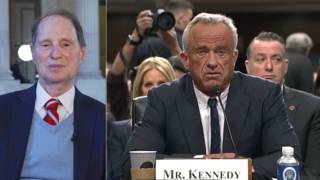
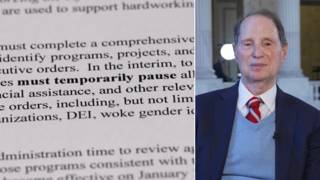

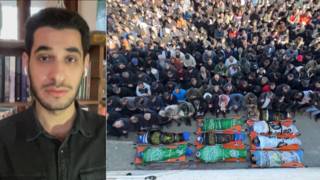
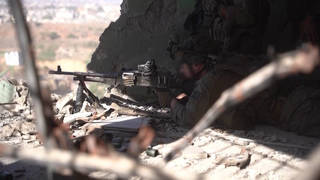





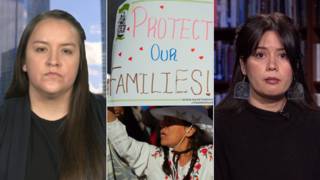
Media Options